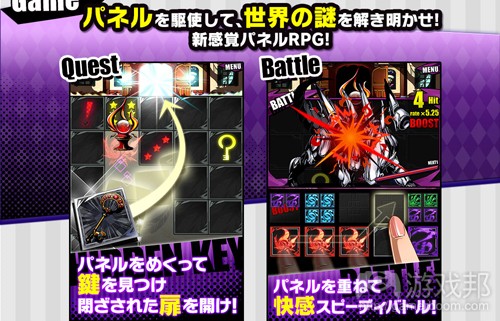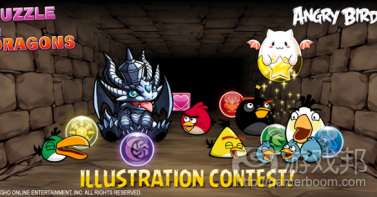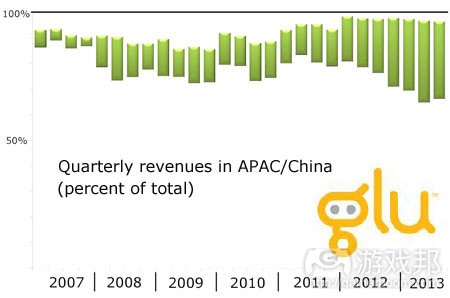每日观察:关注Rovio与GungHo游戏交叉推广合作(11.5)
1)据pocketgamer报道,日本手机游戏公司GungHo Online日前宣布《Puzzle & Dragons》非官方续作《Divine Gate》上线1个月注册用户已经超过100万。
这款RPG游戏采用了与《Puzzle & Dragons》(在日本注册用户已超过2000万)相似的功能,目前仅发布于日本地区,但未来也将推出海外版本。
2)据venturebeat报道,芬兰开发商Rovio最近也宣布与GungHo Online进行交叉推广合作,将让《愤怒的小鸟》角色出现在后者游戏《Puzzle & Dragons》中。
该交叉推广活动时间为11月18日至12月1日,支持《Puzzle & Dragons》玩家挑战愤怒的小鸟主题地下城。
除此之外,Rovio还宣布即日起推出插画大赛,邀请粉丝提交与该交叉推广活动有关的绘画作品,这一活动将持续到11月20日,粉丝可以通过《愤怒的小鸟》Facebook页面提交作品。
3)据pocketgamer报道,法国发行商Gameloft日前公布2013年第三季度(截止9月30日)财报,该季度公司销售额达6170万欧元,同比上年增长11%,超过了竞争对手EA Mobile(仅为7500万美元)。
Gameloft在2013年头9个月总销售额达1.71亿欧元(约2.31亿美元),同比上年增长14%。
第三季度平板电脑和智能手机游戏销售额占比69%,去年同期时占比58%。免费游戏在第三季度销售额中占比55%。
但Gameloft也指出,有80%以上的2013年收益来自2012年及之前发布的游戏。
北美地区销售额占比32%,欧洲和中东地区占比31%,拉美占比20%,亚洲占比16%。
Gameloft预计全年销售额将达2.35亿至2.4亿欧元(3.2亿至3.25亿美元)。
4)据pocketgamer报道,Glu Mobile早在2007年收购MIG公司时就入驻中国市场,自2012年初开始,亚太/中国地区已经成为该公司关键发展动力,目前该地区在Glu收益中占比约三分之一,其比重已经超过欧洲。
Glu首席执行官Niccolo de Masi表示,中国已经成为仅次于美国的Glu第二大市场,韩国则是第三大市场,Glu是中国游戏市场的大型“海外公司”。
5)据CNET报道,任天堂2013上半年销售额有所下滑,并将部分原因归咎于家庭主机市场销售不济,尽管如此任天堂却并未宣布更改硬件为主的商业模式,但也并没有明确反对考虑移动战略。
任天堂美国总裁Reggie Fils-Aime在最近采访中表示,任天堂一直在考虑如何将移动平台作为营销工具,如何以小型内容和体验将用户引向自己的硬件环境。
6)Pew Research Center最新报告显示,仅有16%美国成人使用Twitter,仅有半数人通过该社交网站了解新闻信息,这一比例远逊于Facebook(30%美国成人通过Facebook了解新闻)。
但Twitter用户更为年轻,学历更高,也更为“移动化”和富有,男性比例也比Facebook用户更高。
年收入超过7.5万美元的Twitter用户占比48%,Facebook此类用户则占比41%,Twitter男性用户占比50%,Facebook这一比例则是42%。除此之外,Twitter有45%用户介于18-29岁,而Facebook用户这一比例仅为34%。至少有40%的Twiiter用户获得学士学位,而Facebook用户的这一比例仅为30%。
Twitter有77%用户来自海外地区,在许多发展中国家的年轻移动用户中普及率较高,但在这些地区的收益远低于美国、加拿大、西欧。(本文为游戏邦/gamerboom.com编译,拒绝任何不保留版权的转载,如需转载请联系:游戏邦)
1)Puzzle & Dragons ‘sequel’ Divine Gate hits 1 million in Japan
Is lightning about to strike twice?
by Chris Kerr
Uber-successful Japanese mobile gaming firm GungHo Online has revealed that Divine Gate, the unofficial sequel to Puzzle & Dragons, now has over 1 million registered users.
The panel RPG has similar features to Puzzle & Dragons, such as quests, an evolving/leveling-up system, and end of stage boss battles.
1 million in a month
Even more impressive is the fact that Divine Gate only been available to download for just over a month.
It’s likely that GungHo will quietly be hoping that its newest title can build on this solid foundation, and go on to replicate the success of Puzzle & Dragons – a game that has over 20 million users in Japan.
The game’s success is especially timely, given it comes at a time when Puzzle & Dragons’ growth is slowing in its native Japan. Indeed, profits fallen at the developer in its most recent quarter, down 12 percent to $238 million.
For the time being Divine Gate is only available in Japan, however GungHo have confirmed that an international version is on its way.(source:pocketgamer)
2)Finnish friends: Rovio’s Angry Birds are teaming up with developer GungHo to appear in Puzzle & Dragons
Jeffrey Grubb
The Angry Birds are coming in for a crash-landing in Puzzle & Dragons.
Developers Rovio and GungHo Online Entertainment announced a cross-over event today that will have the fowls from physics puzzler Angry Birds making an appearance in GungHo’s popular Puzzle & Dragons role-playing game.
Starting on Nov. 18 and continuing through Dec. 1, Puzzle & Dragons players can challenge an Angry Birds-themed dungeon. This level will feature the familiar avian characters from the Angry Birds series as the enemies.
“We are excited to announce the collaboration of Puzzle & Dragons and the Angry Birds games from Rovio Entertainment,” Puzzle & Dragons creator Daisuke Yamamoto said in a statement.
“Angry Birds is one of the most recognizable entertainment franchises in the world, and we are thrilled to be working alongside Rovio to give our fans a look at what it would be like if Angry Birds characters invaded the world of Puzzle & Dragons.”
In addition to the cross-over event, Rovio is holding an illustration contest starting today. The developer is inviting fans to submit drawings based on the theme of the Angry Birds showing up in Puzzle & Dragons. The contest will continue until Nov. 20, and fans can enter their work on the Angry Birds’ Facebook page.
“At Rovio we are very happy to bring Angry Birds together with Puzzle & Dragons, and to introduce the fun contest to both games’ fans all over the world,” Rovio vice president of games Jami Laes said in a statement. “It will be exciting to see what our creative fans will come up with.”
Rovio and GungHo Online are two of mobile gaming’s biggest studios. Rovio had early success with its Angry Birds titles, while GungHo is on the upswing with Puzzle & Dragons, which is on pace to make $1 billion per year.
Japanese gamers have downloaded Puzzle & Dragons more than 20 million times. That’s a huge portion of the population, but the title isn’t performing as well in the U.S. Picking up American gamers is likely the motivation behind this event. We’ve reached out to GungHo to ask if this is the case, and we’ll update this post with any new information.
This isn’t the first cross-over promotion GungHo has held with its RPG puzzler. The developer teamed up with Finnish studio SuperCell twice before to cross-promote Puzzle & Dragons with mobile strategy title Clash of Clans. Prior to the second event, GungHo partnered up with Japanese investor SoftBank to make a $1.5 billion investment in 51 percent of SuperCell.(source:venturebeat)
3)Gameloft beats out EA Mobile’s quarter with Q3 sales of $83.5 million
by Jon Jordan
Gameloft (EPA:GFT) has announced its Q3 FY13 financials for the three months ending 30 September 2013.
Sales were a record revenues €61.7 million (around £83.5 million), up 11 percent year-on-year.
Notably this is higher than rival EA Mobile’s sales during the period, which were a disappointing $75 million.
Looking at the nine months of 2013 to-date, Gameloft’s total sales were €171.0 million (around $231 million), up 14 percent year-on-year.
Gameloft doesn’t break out its profit figures until later in the year.
Smarter, freer…
The proportion of total sales due to smartphone and tablets continues to rise – now 69 percent of sales, compared to 58 percent in Q3 2012.
Free-to-play games accounted for 55 percent of Gameloft’s sales in Q3.
However, the company said that over 80 percent of its revenue during 2013 came from titles released during 2012 and earlier.
On the up
In terms of a regional breakdown, its largest market was North America with 32 percent of sales. Europe and the Middle East were 31 percent, Latin America 20 percent, and Asia 16 percent.
Gameloft said it expects full year sales to be between €235 million and €240 million (around $320 million to $325 million).
In 2012, full year revenue was €208.3 million (around $275 million).(source:pocketgamer)
4)Glu is the foreign company that’s big in China, says CEO
by Jon Jordan
Plenty of western mobile games have been successful in China.
As with everywhere else in the world, Clash of Clans is currently riding high in the top grossing iOS charts.
Meanwhile titles such as Temple Run 2, Fruit Ninja and Plants vs. Zombies 2 are also star performers; a position they’ve gained as their developers are working closely with specialist Chinese publishers such as iDreamsky and Yodo1.
But there are some international companies – not just individual games – that are also doing the business.
Slow train coming
One thing often forgotten about Glu Mobile is that it’s had an operation in China since its 2007 acquisition of MIG; a deal which at the time caused all manner of financial issues.
Now, however, looking at its recent financials, it’s clear how important the region is to the company’s future.
Starting in early 2012, the APAC/China region has been a key growth area for Glu, particularly as North America revenue have declined. It now accounts for around a third of revenues – much more than Europe.
It’s perhaps easier to see to this in the following graph, which breaks out the regions in terms of their percent of sales. (I’ve removed all the other regions for clarity.)
Of course, given the growth of the Korean, Japanese and Chinese mobile games markets over the past 18 months, perhaps this shouldn’t be a surprise.
But according to Glu’s CEO Niccolo de Masi, China is already the company’s second largest market after the US, and followed by Korea.
“Glu is the ‘foreign company’ that is big in China,” he says.(source:pocketgamer)
5)Nintendo opens up to mobile as giant posts meagre profit
by Matthew Diener
Despite slow Wii U sales, Nintendo has announced a modest profit of ¥600 million (around $6.1 million) for the six months ending September 2013, up from a ¥28 million loss during the same period last year.
Sales at the company slipped, however, down 2.2 percent year on year to ¥196.6 billion ($2 billion), with Nintendo blaming its continued difficulties – in part – on its much maligned home console.
Indeed, the Japanese giant directly cited “advertising activities to increase sales, and research and development for the ‘Wii U’ software among others”.
Despite these less-than-stellar sales figures, however, Nintendo did not make any announcements to alter its hardware-focused business model despite the calls from analysts and investors to expand into the ever-growing mobile gaming market.
Yet as it turns out, Nintendo isn’t unilaterally opposed to mobile as a concept.
The door’s still open
“We’re constantly thinking about how to leverage mobile as a marketing vehicle,” said Nintendo of America’s President Reggie Fils-Aime when discussing its strategies with CNET.
“How do I give little tastes of content, little experiences that then drive the consumer back to my hardware environment?”, Fils-Aime added.
These ‘little tastes’ won’t translates to full mobile ports of Mario Bros. any time soon, however.
“When the consumer wants to play Mario, Zelda, and Pokemon, they have to purchase our hardware to do so. And that preserves our overall financial model.”
And this model is key to bringing Nintendo deeper into the black during the next earnings calls, as it hasn’t altered its forecasted ¥100 billion ($1 billion) operating profit for the year with much of its faith riding on the global launch of Pokemon X and Y for the 3DS in October.(source:pocketgamer)
6)Only 16% of U.S. adults use Twitter (but they’re smart, young, and rich)
John Koetsier
Only 16 percent of U.S. adults use Twitter, and only half of them get news via the short-message social network, according to a new survey by Pew Research Center. That’s far fewer than Facebook, where 30 percent of American adults get their news.
The good news for Twitter?
Twitter users skew younger, more educated, more mobile, and more wealthy. Oh, and they’re more male too, than Facebook users.
Twitter users are more likely to make more than $75,000 a year than Facebook users — 48 percent to 41 percent — and also more likely to be male: 50 percent versus Facebook’s 42 percent. Those facts may, of course, be related, as men tend to earn more than women even to this day. In addition, Twitter users are more likely to be young, with 45 percent of them between 18 and 29 years of age, versus 34 percent of Facebook users, and more likely to be better educated, with at least 40 percent of them earning a Bachelor’s degree or more, versus 30 percent for Facebook.
Still, with all that good news for a dream advertisers’ demographic, it’s hard to get around that one core glaring statistic: Only a small slice of American’s actually use the social media darling of the now.
This is not new news, of course.
77 percent of Twitter’s users are outside the United States, as we learned from its IPO documentation, and the company has massive penetration among the young, mobile-savvy populations of many developing nations. The only problem is that they bring in much less revenue than American, Canadian, and western European users.
The problem is that Twitter’s user growth has essentially stalled in the U.S. That’s something the company needs to fix, and quickly, as it goes public — and after.(source:venturebeat)











































 闽公网安备35020302001549号
闽公网安备35020302001549号